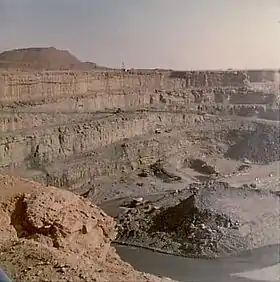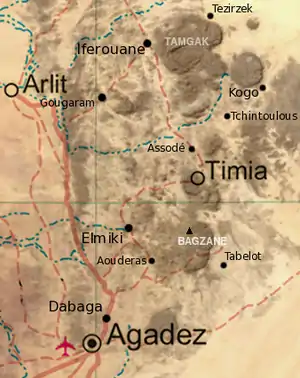Arlit
Arlit is an industrial town and capital of the Arlit Department of the Agadez Region of northern-central Niger, built between the Sahara Desert and the eastern edge of the Aïr Mountains. It is 200 km south by road from the border with Algeria. As of 2011, the commune had a total population of 112,432 people.[1]
Arlit | |
|---|---|
 The open pit Uranium Mine at Arlit | |
 Arlit Location in Niger | |
| Coordinates: 18°44′N 7°23′E | |
| Country | |
| Region | Agadez Region |
| Seat | Arlit Department |
| Elevation | 425 m (1,394 ft) |
| Population (2011) | |
| • Total | 112,432 |

Uranium industry
Founded in 1969 following the discovery of uranium, it has grown around the mining industry, developed by the French government. Two large uranium mines, at Arlit and nearby Akouta, are exploited by open top strip mining. One open pit mine was built in 1971 by the National Mining Company of Niger, SOMAIR.[2] The Second open pit mine, as well as a third underground mine, was built by the French Compagnie Minière d'Akouta (or COMINAK).[3] All the ore from both is now processed and transported by a French company Orano Cycle, a holding of the Orano group, itself a state owned operation of the French Commissariat à l'énergie atomique (CEA). The system of French nuclear power generation, as well as the French nuclear weapons program, is dependent on uranium mined at Arlit.[4] Orano Cycle alone employs 1600 foreign nationals on the site.[5]
In 2017, 2,116 tonnes of uranium were extracted from the Arlit mines[6] and exported to France via truck to the seaport at Cotonou, Bénin. At its peak in the 1980s, 40% of Niger's uranium production came from Arlit, and uranium represented 90% of Niger's exports (by value). A major modern road, known as the Uranium Highway, has been built to transport uranium south, but it has bypassed many towns along the way (In-Gall for example) and has radically changed Niger's transportation system.
Boom, bust and recovery
In the late 1980s, Arlit suffered from a steep decline in world uranium prices, and the number of foreign employees in the town was cut to 700, a drop which has rebounded by the first decade of the 21st century. The value of Niger's uranium "boom" has never recovered its 1980s level, causing dislocation and suffering for the tens of thousands of Nigeriens who flocked to the shanty towns surrounding Arlit.
Anger at the results of uranium bust, along with a belief that the best jobs were going to those from southern Niger, contributed to the Tuareg Rebellion of the 1990s. As late as 2007, Tuareg nationalists have made a fairer division of profits and jobs for local people a primary demand.[7]
Environmental impact
The impact on the local environment of the Arlit mining industry has been criticised by African and European Non-Governmental Organisations, and Areva NC has especially been accused of a disregard for health and environmental conditions around its operations.[8]
"Yellowcake" controversy
In the build-up to the war in Iraq there was controversy over allegations in 2003 that Saddam Hussein was seeking to purchase uranium from Arlit.
Expatriates and immigrants
%252C_street_scene.jpg.webp)
Arlit has developed a first-world infrastructure and airport to serve European workers and their families, and has become a transit point for illegal immigrants attempting to travel to Algeria, and from there, France.
Military base
The United States has operated a military base in Arlit since approximately 2015.[9][10][11]
Transportation
Arlit is served by Arlit Airport.
In popular culture
In 2005 the Beninese filmmaker, Idrissou Mora-Kpaï, produced and directed the film Arlit, deuxième Paris (Arlit, a Second Paris) about the large expatriate community in the town.
In 2007 Andersen Press published 'The Yellowcake Conspiracy', a novel by British children's author Stephen Davies. The novel is an espionage thriller set in and around the Arlit mine.
Geology
More than 25 uranium deposits occur with Mississippian to Cretaceous age sandstones. Key structural features are the Arlit Fault, and intrusions and ring dikes from 480 to 145 Ma in age.[12]
Climate
Arlit has a hot desert climate (BWh) in Köppen-Geiger system.
| Climate data for Arlit | |||||||||||||
|---|---|---|---|---|---|---|---|---|---|---|---|---|---|
| Month | Jan | Feb | Mar | Apr | May | Jun | Jul | Aug | Sep | Oct | Nov | Dec | Year |
| Average high °C (°F) | 26.9 (80.4) |
30.1 (86.2) |
34.3 (93.7) |
38.6 (101.5) |
41.2 (106.2) |
41.5 (106.7) |
39.8 (103.6) |
38.6 (101.5) |
39 (102) |
37 (99) |
32.3 (90.1) |
28.4 (83.1) |
35.6 (96.2) |
| Daily mean °C (°F) | 18.8 (65.8) |
21.7 (71.1) |
25.9 (78.6) |
30.5 (86.9) |
33.4 (92.1) |
34.2 (93.6) |
32.8 (91.0) |
31.9 (89.4) |
31.8 (89.2) |
29.3 (84.7) |
24.2 (75.6) |
20.5 (68.9) |
27.9 (82.2) |
| Average low °C (°F) | 10.8 (51.4) |
13.3 (55.9) |
17.5 (63.5) |
22.4 (72.3) |
25.7 (78.3) |
27 (81) |
25.9 (78.6) |
25.3 (77.5) |
24.6 (76.3) |
21.6 (70.9) |
16.1 (61.0) |
12.7 (54.9) |
20.2 (68.5) |
| Average precipitation mm (inches) | 0 (0) |
0 (0) |
0 (0) |
1 (0.0) |
1 (0.0) |
5 (0.2) |
11 (0.4) |
18 (0.7) |
5 (0.2) |
0 (0) |
0 (0) |
0 (0) |
41 (1.5) |
| Source: Climate-Data.org, altitude: 429[13] | |||||||||||||
References
- "Annuaires_Statistiques" (PDF). Institut National de la Statistique. Retrieved 2 May 2013.
- Somair Company Profile.
- Georges Capus, Pascal Bourrelier and Moussa Souley (2004). "Uranium Mining in Niger; Status and Perspectives of a Top Five Producing Country". World Nuclear Association- N.B.: The WNA is a nuclear industry funded group.
- France and Nuclear Energy Archived 16 October 2007 at the Wayback Machine and French Involvement in Niger Archived 4 July 2007 at the Wayback Machine, both from Pederson, Nicholas R. The French Desire for Uranium and its Effects on French Foreign Policy in Africa. Arms Control, Disarmament, and International Security: Occasional Papers. PED:1. University of Illinois at Urbana-Champaign (2000)
- according to Le Canard Enchaîné (3 August 2005)
- http://www.world-nuclear.org/information-library/nuclear-fuel-cycle/mining-of-uranium/world-uranium-mining-production.aspx
- [ l'Humanite, ] June 2007.
- Le dossier sur la mine d'Arlit de la CRIIRAD
- Taub, Ben (28 January 2018). "Ben Taub on Twitter: "Secret military base near Arlit, Niger, revealed as a white dot in a sea of black, because Western soldiers didn't turn off their Fitbits". Twitter via the Internet Archive. Archived from the original on 28 January 2018. Retrieved 25 August 2020.
- Müller-Jung, Friederike (23 November 2016). "US drone war expands to Niger". Deutsche Welle.
An additional US base in Arlit, about 250 kilometers (155 miles) north of Agadez, has been operating for about a year, but little is known about it, Moore said, except that special forces are presumably stationed there.
- Lewis, David; Bavier, Joe. Boulton, Ralph (ed.). "U.S. deaths in Niger highlight Africa military mission creep". Reuters.
In missions run out of a base in the northern Niger town of Arlit and others like the one that led to the ambush of U.S. troops, sources say they have helped local troops and intelligence agents make several arrests.
- Nash, J. Thomas (2010). Volcanogenic Uranium Deposits: Geology, Geochemical Processes, and Criteria for Resource Management. Reston: USGA. p. 36.
- "Climate: Arlit – Climate graph, Temperature graph, Climate table". Climate-Data.org. Retrieved 3 October 2013.
External links
| Wikimedia Commons has media related to Arlit. |
- Website and photos of the town (in French) (Translate to English: Google, Bing)
- Rejets de la mine d'uranium d'Arlit, massif de l'Aïr, Niger (19°00' N – 7°38' E) (in French) (Translate to English: Google, Bing)
- agadez.org page on Arlit (in French) (Translate to English: Google, Bing).
- Mines d'uranium au Niger : Un scandale nommé COGEMA (in French) (Translate to English: Google, Bing): Le nucléaire, l'uranium et l' "indépendance énergétique" française (B. Belbéoch).
- La production d'Uranium au service du développement durable (in French) (Translate to English: Google, Bing), on the official site of the Areva mining company.
- A forgotten community: The little town in Niger keeping the lights on in France
- googlemaps